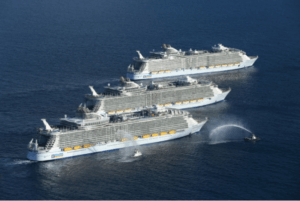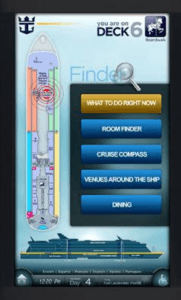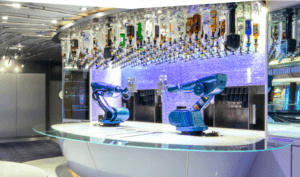Royal Caribbean: Digitization on the High Seas

As ships keep growing bigger, how can a cruise company maintain personalized guest service?
Cruise ships have grown to, essentially, floating cities, the home to 6,000 paying passengers. Royal Caribbean is the owner of the world’s 3 largest passenger ships and has invested heavily to make these vessels “smart ships,” wired from stem to stern to enhance the customer experience and deliver on the brand promise: “We push the limits of the imagination….We call it the Royal AdvantageSM…the most innovative ships, exciting worldwide destinations and best personalized service to each and every guest.” [1]
There is one additional—often caricatured—piece to RC’s brand promise: endless indulgence. While RC never baldly states its intention to ply its guests with food and drink, its technology choices make clear that access to comestibles is of top importance.
Indeed, as waistlines and ship lengths expand, technology has allowed RC to deliver highly efficient service and, at its best, personalized magic.
Efficient Service
Each ship has 2,000 crewmembers, and RC uses digital systems to coordinate and manage this workforce, finding efficiencies along the way.
The size of RC’s ships is a challenge. With upwards of 16 floors and lengths topping 4 football fields [2], walking from cabins to central control areas to workstations can take 15-30 minutes per crewmember, time which could be better spent helping guests, cooking shrimp, or swabbing decks. That’s why RC overhauled and decentralized its shift processes, installing an integrated IT solution and arming its staff with computerized workstations and tablets. Whereas crewmembers used to “punch in” at the start of their shifts and pick-up work orders at a single central office, they can now head straight to their work areas, track time electronically, receive work orders, report completions, and move to their next tasks independently. [3]
The greatest efficiencies have been in food safety proceses. RC complies with standards set out by the U.S. Public Health Service Act, which aims at preventing food-borne illness. The industry is well-known for—and extremely damaged by—horror stories of norovirus infecting ships, so delivering safe food is a priority.
Traditionally, the process was labor-intensive: employees had to use a thermometer to manually check the temperature of food and storage areas, with one full round of inspections clocking in at 5 hours. RC partnered with tech firms to adopt handheld monitoring devices that measure temperature and integrate with software to create compliance reports. Employees can also easily check previously-recorded temperatures of coolers, and receive an automatic alert and suggested actions when coolers breakdown.
These digital solutions have reduced food safety checklisting time from 5 to 2 hours. [3]
“Limits of Imagination”
RC has deployed technology to make the guest’s logistical experience as painless as possible. Using an app called Royal iQ, guests can track their luggage arrival, book dinner reservations, and navigate the activity schedule. [4]
RC has also introduced the use of “WOWbands,” silicon bracelets that use radio-frequency technology to let passengers unlock cabins, purchase drinks and merchandise, and confirm reservations with a simple tap. These tech wearables aim to replace the too-easy-to-lose hotel keycards. [5]
Further, RC has cleverly deployed technology to deliver magical experiences—the Royal Advantage—for its guests. While the company employs the usual grab bag of Big Brother tricks—distributing food inventory based on head-counting cameras in the ceilings of dining rooms [6], for example—it also invests heavily in attractions guests will see nowhere else. RC built the world’s first Bionic Bar—robots that take orders by iPad and produce 2 mixed drinks per minute [7]. If guests prefer a little more autonomy, there’s the $65/day “Ultimate” beverage: each “Ultimate” guest receives a cup with a radio-frequency chip in its base, which activates a self-serve drink machine that gives access to a hundred different soft-drink combinations and flavorings from across the world. The machine also automatically orders refills for itself when flavorings run low. [8]
Perhaps most impressively, RC has created “virtual balconies” for rooms without a view: floor-to-ceiling LED screens feature live footage from around the ship and speakers pipe in “natural sounds” so guests buried deep in the bowels of these behemoth boats can take in the surrounding ocean. [4]
What’s Next?
RC should use technology to expose guests to the engineering achievements of the very ships they are on. Guests would love to know more about the advanced technology that go into the navigation and running of such a huge operation, and “virtual balconies” could let guests experience what it’s like to stand at the helm.
Operationally, RC could mandate all cross-trained service workers to wear real-time trackers so that they can be redistributed if there is a surge in guests wishing to dine at one particular restaurant or to take in one attraction. Long waits or limited reservations could become a thing of the past with a such flexible, mobile, and trackable workforce.
Word Count: 797
[1] Royal Caribbean, “The Royal Advantage.” http://www.royalcaribbean.com/contentSitelet.do?pagename=royal_advantage_main
[2] USA Today, “Five Facts About Cruise Ships.”
http://traveltips.usatoday.com/five-cruise-ships-111054.html
[3] Microsoft, “Customer Stories: Royal Caribbean.”
https://www.microsoft.com/en-us/cloud-platform/customer-stories-royal-caribbean
[4] Royal Caribbean, “Previewing Harmony of the Seas: Technology.”
http://www.royalcaribbeanblog.com/2015/09/24/previewing-harmony-of-the-seas-technology
[5] Royal Caribbean, “Royal Caribbean WOWbands: What You Need to Know.”
http://www.royalcaribbeanblog.com/2014/11/19/royal-caribbean-wowbands-what-you-need-know
[6] Conde Nast Traveler, “How Does Mega Cruise Ship Source, Store, and Prepare All That Food?”
http://www.cntraveler.com/stories/2012-10-12/cruises-restaurant-quality-food-explained
[7] Royal Caribbean, “Bionic Bar Powered by Makr Shakr.”
[8] New Yorker, “Floating Feasts.”
http://www.newyorker.com/magazine/2014/11/03/floating-feasts







Haha, i loved this. It brought back memories of touring cruise ships for work and stuffing my face full of any and every piece of food that was within reach. One of the things I know Royal Caribbean also is investing heavily in is internet connectivity on ships as cruise lines were notorious for having terrible connectivity (but perhaps one of the draws for those who want to totally disconnect).
One of the thing I wonder about for the cruise industry is if they have to change some of their fundamental philosophies about what a vacation means to target younger cruisers. What I mean by this is if say millennials care more about the destination, do they really need these super large ships that cannot get to some of these very remote places? Similarly, do they care more about these add-on all you can eat packages? Do you think the cruise industry needs to take it a step further and think about not only ways that technology can make things better for their current customer but how they can use it to attract the next generation of cruisers who may not have the same tastes?
This is an awesome post. I never think about the traditional cruise line industry in terms of being at the forefront of technological innovation but after reading this I understand why technology can will continue to play such a significant role. I wonder if Royal Carribean can continue to invest in these new technologies and find a way to license them to other competitors in the hospitality industry. I would also be curious to understand how technology has played a role from a safety perspective on these large ships and what role if any it can play to reduce the health issues inherent in having so many people in such close proximity. I feel like at least 1x a year I hear about a cruise line having a serious health issue on board and that has always made me hesitant to go on a cruise in the first place.
Building on Jake’s point re commercializing technology, the robotic bartender has incredible potential to disrupt the on-land hospitality industry. Although the technology no doubt was developed at sea because of high labor costs and small spaces available, I see no reason why you couldn’t expand the robot into every bar, pub and nightclub in the world and remove a bottleneck that is a huge pain at bars I’ve been to all over the world. The capital cost to bar owners would repay itself likely within a year, as they don’t have to pay staff (let alone staff on late night and weekend penalty rates).
It poses an interesting question for how Royal Caribbean could benefit from this innovation, given that (after all) they aren’t a robotics company and presumably they didn’t invent the technology in-house. One option would be to partner with the robotics company in offering their ships as the basis for a trial, but taking a minority equity stake in the robotics company (or, even better, purchase an option to own the equity of the supplier contingent on a successful pilot). This way they could share in the upside for using their ships and customers as part of the technological innovation testing process.
This is fascinating, thanks Kiernan! I am really impressed at how RC has embedded technology throughout its operations. To take this a step further, I wonder how RC could use AR/VR aboard its ships. This could increase the variety of entertainment on offer for guests without the need for more costly space. For example, passengers could participate in a “real life” go-kart tournament with one another, or “swim” in the sea beneath them and witness the sealife they are amidst.